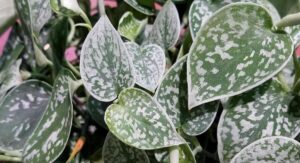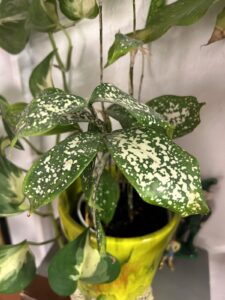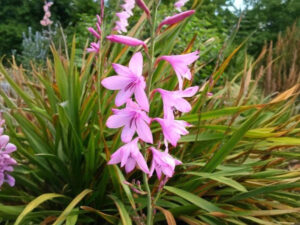
If you’ve ever browsed the houseplant section of a garden center and felt confused about whether you were looking at a pothos or a philodendron, you’re not alone. These two popular houseplants look remarkably similar at first glance, leading to frequent misidentification.
Both make excellent houseplants for beginners and plant experts alike, featuring heart-shaped leaves and trailing vines that can transform any space into a lush indoor jungle. But despite their similarities, pothos and philodendrons are distinctly different plants with unique characteristics that are worth understanding—especially if you want to provide optimal care for your green friends.
In this article
Warning
While both plants are considered relatively safe houseplants, it’s important to note that pothos (Epipremnum aureum) and heartleaf philodendron (Philodendron hederaceum) contain calcium oxalate crystals that are toxic if ingested. Keep both plants away from curious pets and children who might chew on the leaves. Symptoms of ingestion can include oral irritation, excessive drooling, vomiting, and difficulty swallowing.
Differences Between Pothos and Philodendrons
Before diving into the detailed distinctions, here’s a quick reference comparison table to help you identify whether your plant is a pothos or a philodendron:
| Feature | Pothos (Epipremnum aureum) | Heartleaf Philodendron (Philodendron hederaceum) |
|---|---|---|
| Taxonomy | Belongs to Epipremnum genus | Belongs to Philodendron genus |
| Leaf Shape | Heart-shaped with uneven sides, often slightly elongated or asymmetrical | More uniformly heart-shaped with symmetrical sides |
| Leaf Texture | Waxy, thicker leaves with slightly raised or bumpy texture | Thinner, smoother leaves with a velvety texture |
| Leaf Color | Usually variegated; new leaves emerge with an established pattern | Often solid green; new leaves may appear reddish or bronze |
| Aerial Roots | Thicker, fewer aerial roots (typically one per node) | Multiple thin aerial roots per node |
| Petioles | Curved inward with a noticeable groove | Round and more uniform in shape |
| Growth Habit | Displays a more random, sprawling growth pattern | Tends to grow more orderly, with leaves often aligning in the same direction |
| New Leaves | Unfurl from a protective sheath that eventually falls off | Unfurl from a cataphyll (a type of protective sheath) that stays attached to the stem even after the leaf has expanded |
| Growth Rate | Slightly slower than Philodendrons | Typically faster-growing under similar conditions |
Now, let’s examine each of these differences in greater detail.
Taxonomy
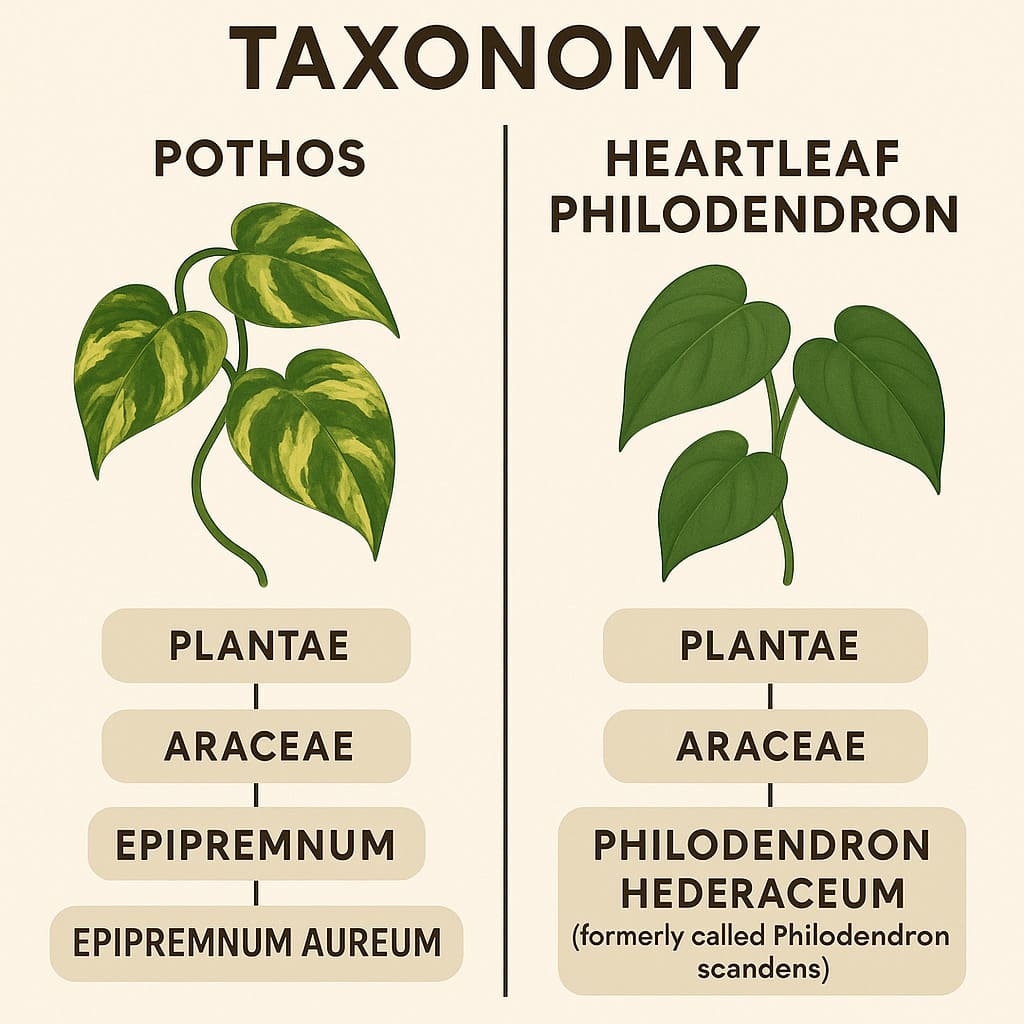
The confusion between these plants begins with their scientific classification. While they’re both members of the Araceae (aroid) family, they belong to completely different genera:
- Pothos: Belongs to the Epipremnum genus, with the most common variety being Epipremnum aureum
- Heartleaf Philodendron: Belongs to the Philodendron genus, with the most common variety being Philodendron hederaceum (formerly called Philodendron scandens)
“The taxonomy confusion isn’t helped by the fact that pothos is sometimes called ‘devil’s ivy’ or even incorrectly labeled as ‘philodendron’ in garden centers,” explains botanist Dr. Elena Rivera. “The plants evolved similar characteristics despite being from different genera because they adapted to similar environmental niches.”
Leaf Shape and Texture

The leaves offer one of the most reliable ways to distinguish between these two plants:
Pothos Leaves:
- Typically heart-shaped but often slightly elongated
- Sides of the leaf are usually uneven (asymmetrical)
- Thicker, waxier texture with a slightly raised or bumpy surface
- Leaves often feel stiffer and more substantial
- Generally have more pronounced variegation in varieties like Golden Pothos, Marble Queen, and Neon
Philodendron Leaves:
- More perfectly heart-shaped with a pronounced “dip” at the top of the heart
- More symmetrical on both sides
- Thinner, smoother texture with a velvety feel, especially on new growth
- Leaves are more flexible and softer to the touch
- Often solid green, though variegated varieties exist
“If you’re still unsure after looking at the leaf shape, run your finger along the surface,” suggests houseplant specialist Jamie Wong. “Philodendron leaves have that distinctive soft, almost velvety texture that pothos leaves lack.”
Aerial Roots and Petioles
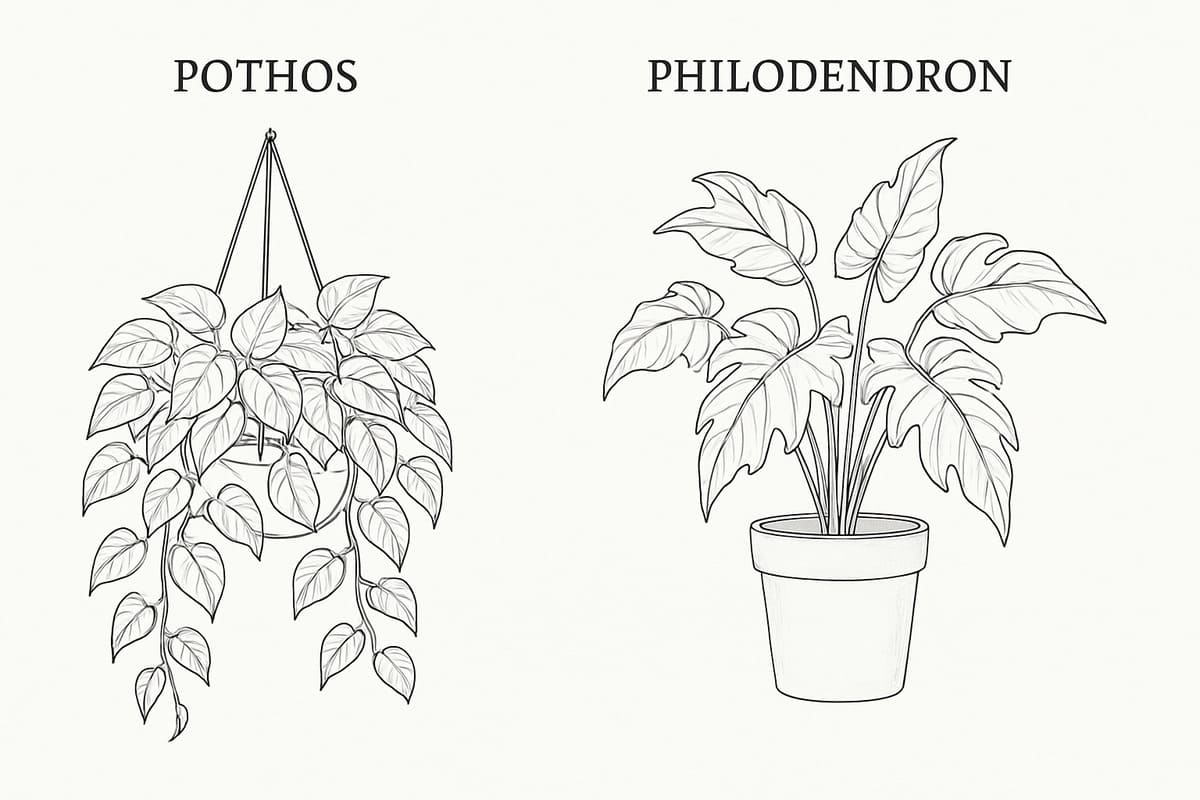
Both plants produce aerial roots to help them climb in their natural habitats, but there are noticeable differences in their root structures:
Pothos Aerial Roots:
- Usually produces only one thick aerial root per node
- Roots appear more bumpy and textured
- Aerial roots tend to be shorter and stubbier
- Less likely to attach to surfaces when grown indoors
Philodendron Aerial Roots:
- Produces multiple thin aerial roots per node
- Roots appear smoother and more uniform
- Aerial roots are often longer and more delicate
- More readily attach to surfaces like moss poles
The petiole (the stem that connects the leaf to the main vine) also differs between the two plants:
Pothos Petioles:
- Feature a groove or indentation that runs along the length of the petiole
- Often curve inward toward the vine
Philodendron Petioles:
- Completely round with no grooves
- Maintain a more uniform thickness throughout
“The petiole difference is one of the most reliable ways to distinguish between the two plants,” notes Dr. Rivera. “If you see that distinct groove in the leaf stem, you’re almost certainly looking at a pothos.”
Growth Habits and New Leaves
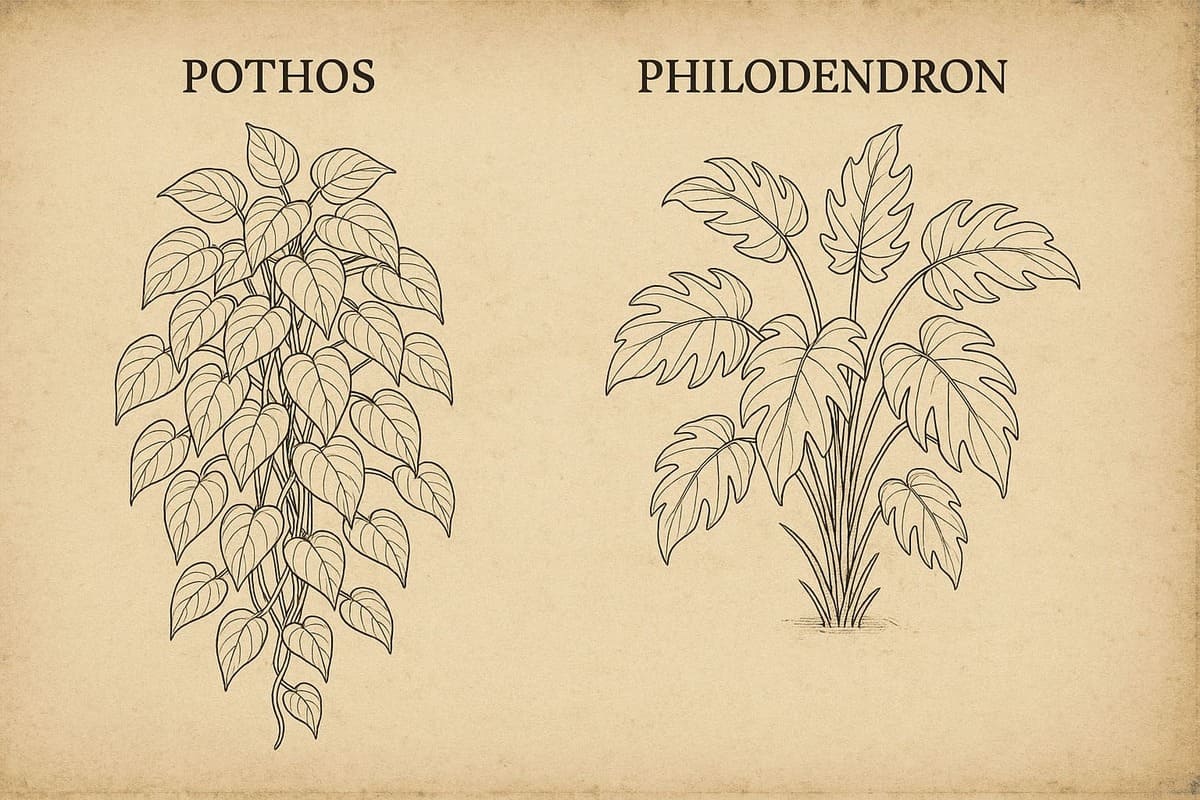
Observing how new leaves develop provides perhaps the clearest distinction between these two plants:
Pothos New Growth:
- New leaves emerge from a sheath that completely falls off once the leaf unfurls
- New leaves emerge with established variegation pattern (if it’s a variegated variety)
- Growth tends to be more random and sprawling
Philodendron New Growth:
- New leaves emerge from protective sheaths called cataphylls that remain attached to the stem, eventually drying up but not falling off
- New leaves often emerge with a reddish or bronze color before maturing to green
- Growth tends to be more organized, with leaves often pointing in the same direction
Philodendrons also typically grow faster than pothos under the same conditions. If your plant seems to be putting out new leaves at an impressive rate, it’s more likely to be a philodendron.
Maintenance of Pothos vs. Philodendron
When it comes to care requirements, pothos and philodendrons have similar needs, which explains why they’re both popular as low-maintenance houseplants. However, there are subtle differences worth noting:
Light Requirements:
- Pothos tolerates lower light conditions slightly better than philodendrons
- Philodendrons may lose their leaf color and become leggy more quickly in insufficient light
- Both perform best in bright, indirect light, though neither should be placed in direct sunlight
Watering Needs:
- Pothos is more drought-tolerant and can bounce back from occasional neglect
- Philodendrons prefer more consistent moisture and will show signs of distress (drooping leaves) if allowed to dry out completely
- Both are susceptible to root rot if overwatered
Humidity Preferences:
- Philodendrons appreciate higher humidity levels, reflecting their tropical rainforest origins
- Pothos is more tolerant of average household humidity
- Both benefit from occasional misting, especially in dry environments
Fertilization:
- Both plants have modest fertilization needs
- Feed monthly during growing season (spring and summer) with a balanced houseplant fertilizer diluted to half strength
- Reduce or eliminate fertilization during fall and winter when growth naturally slows
“I find that philodendrons are slightly needier when it comes to watering frequency,” says Wong. “My pothos can go two weeks without water and perk right back up after a good soak, while my philodendrons start to droop dramatically if I wait that long.”
Another Confusing Houseplant: The Satin Pothos
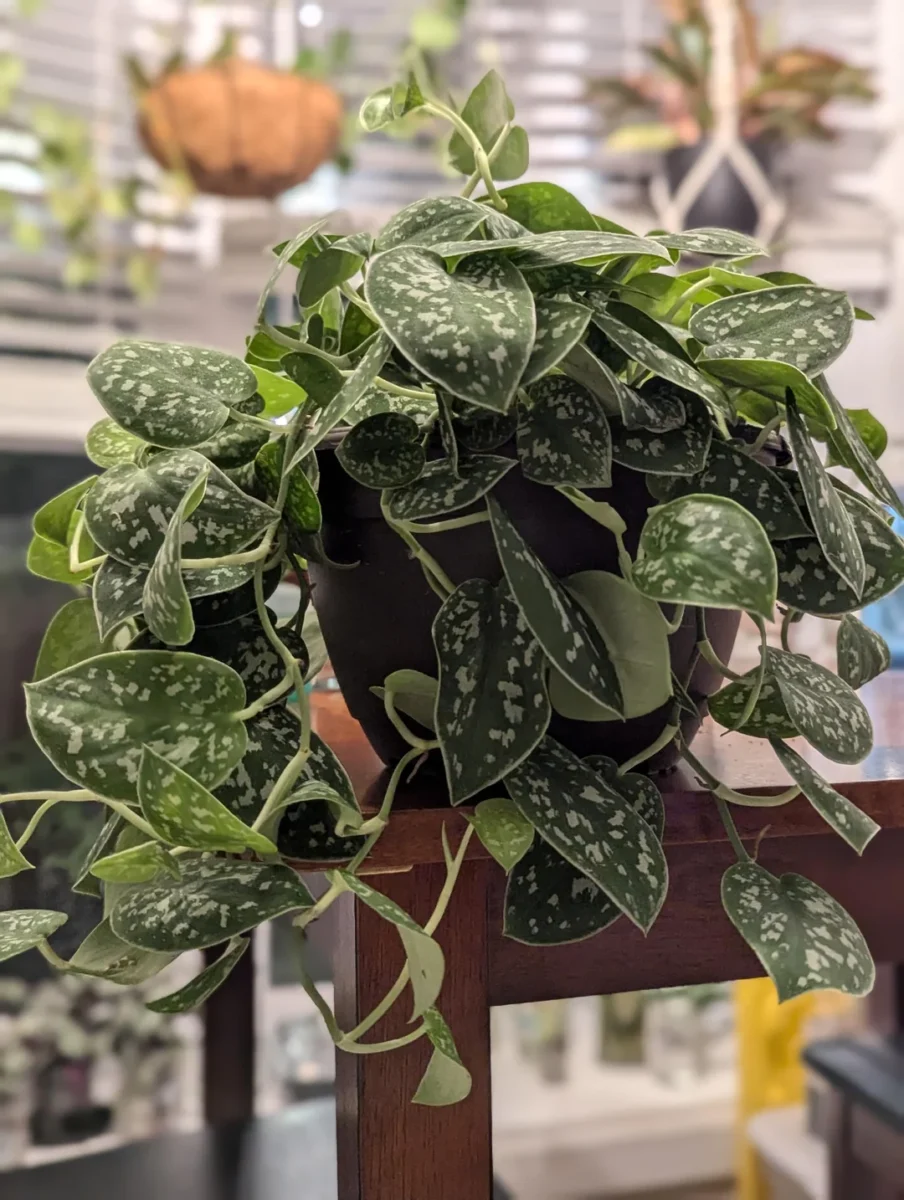
Adding to the identification confusion is the popular “satin pothos” or “silver pothos” (Scindapsus pictus), which despite its common name, is neither a true pothos nor a philodendron but belongs to yet another genus.
The satin pothos features:
- Silver-spotted, heart-shaped leaves
- Thicker, almost leathery texture
- More compact growth habit than either pothos or philodendron
- Higher light requirements than both pothos and philodendron
If your “pothos” has silvery markings rather than the cream or yellow variegation typical of true pothos varieties, you’re likely looking at a Scindapsus pictus.
Frequently Asked Questions
Are pothos or philodendrons better for beginners?
Both plants are excellent for beginners, but pothos has a slight edge in forgiveness for inconsistent watering and lower light conditions. If you’re prone to forgetting to water your plants, start with a pothos.
Can pothos and philodendrons be propagated the same way?
Yes, both plants root readily from stem cuttings placed in water. Cut below a node, remove the bottom leaf or two, and place in water. Roots typically develop within 1-3 weeks, and the rooted cutting can then be planted in soil.
Do pothos and philodendrons clean the air?
Both plants were included in NASA’s clean air study and can help remove trace amounts of formaldehyde and other volatile organic compounds (VOCs) from indoor air. However, the effect is modest in typical home settings, and you would need many plants to make a significant difference in air quality.
Why is my pothos/philodendron not variegated anymore?
Loss of variegation usually indicates insufficient light. Variegated plants need brighter light than their solid green counterparts to maintain their patterns. Move your plant to a brighter location (but not direct sun) to encourage more pronounced variegation.
How big do pothos and philodendrons get?
In their natural habitats, both plants can grow vines reaching 20-40 feet in length. Indoors, they’re typically kept to more manageable sizes through pruning, but can easily grow vines 6-10 feet long if allowed to trail from a shelf or hanging planter.
Can pothos and philodendrons be planted together?
While they can coexist in the same pot due to their similar care requirements, it’s generally better to keep them separate to avoid competition for resources and to make it easier to adjust care if needed based on each plant’s specific preferences.
Whether you ultimately choose a pothos or a philodendron for your home, both make wonderful additions to any indoor plant collection. Their ease of care, attractive trailing growth habit, and ability to thrive in typical indoor conditions have rightfully earned them their popularity among houseplant enthusiasts of all experience levels.
And if you’re still not sure which plant you have at home? Take a close look at the petioles, feel the leaf texture, and watch how new leaves emerge—these three characteristics will give you your answer.
RELATED: 7 Stunning Variegated Houseplants to Brighten Your Home
